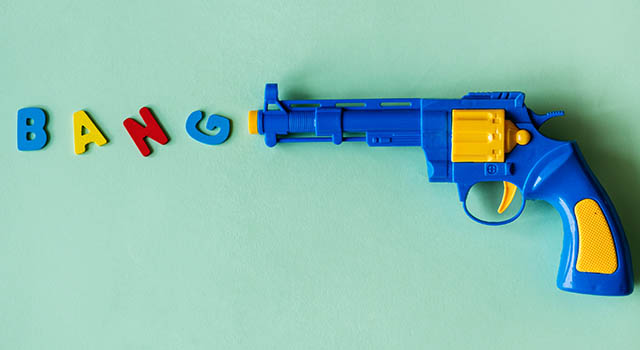Over 225,000 toy-related eye injuries occur in the U.S. every year.
Purchasing gifts for children is not always easy. Every year, more and more toys and games are placed on the market, attracting the attention of young children.
The question is, how safe are these toys for a child’s eyes and vision?
Between 2015 and 2018, over 1 million toy-related injuries were treated in emergency rooms across the U.S., with boys accounting for over 66% of all these injuries.
Do toys cause eye injuries?
Each year, thousands of children sustain toy-related eye injuries, with many of these injuries resulting in permanent vision loss.
According to the USA National Electronic Injury Surveillance System (NEISS), the statistics on toy guns are:
- 6,617 eye injuries occurred between 2010 and 2019
- 61% of these traumas occurring in children under 9 years old
The most common pediatric eye injuries include:
- Black eyes
- Lacerations and bleeding in and around the eye
- Corneal abrasions – scratches to the outer surface of the eye
- Corneal hyphemia – collection of blood inside the eye
- Ruptured or punctured eyeball
- Retinal detachment
Eye safety awareness and the understanding which features make a toy more dangerous is essential knowledge for all parents and caregivers.
Below is a guide to the type of toys that cause the majority of eye injuries:
1. Toy guns and other projectiles
Every year, emergency rooms treat over 600 eye injuries from toy guns alone, with 80% of these eye injuries affecting young boys.
Toy guns nowadays can shoot projectiles up to 100 feet away, making them especially dangerous for younger children who may be unaware that shooting in close proximity of other children or adults can pose a risk of eye injury.
Even guns that shoot soft projectiles, water guns or water balloon launchers can cause blunt force eye trauma and lead to retinal detachment or vision loss.
2. Toys with pointed or sharp ends
Here’s a simple but important idea – if it’s pointy, it’s risky!
Swords, darts, light sabers, wands, bows and arrows and fishing poles are all toys to avoid. A brief accidental contact between any of these objects and the eye can cause serious eye injuries, including lacerations to the eyeball or surrounding areas.
Even if the toy’s packaging states that it is age appropriate, think twice before giving a young child a gift with pointy or sharp edges.
3. Aerosol spray or streamers
The chemicals that come out of these aerosol cans get into a child’s eye, and cause chemical conjunctivitis (pink eye), or a bacterial, viral or fungal eye infection.
These sprays often contain chemicals that can lead to chemical conjunctivitis, corneal abrasions, internal or external eye infections, permanent corneal scarring and sight-threatening burns if sprayed directly into the eyes.
SEE RELATED: Guide to Pediatric Eye Conditions
Schedule an appointment with an eye doctor near you to learn more about eye safety in children.
4. Fireworks or firecrackers
It is never recommended for children to handle fireworks or firecrackers, as they pose a high risk of all types of bodily injuries.
Children should never play with fireworks or similar items.
Firecrackers, rockets, and similar items all carry dangerous explosives and many are not made to FDA standards, so can ignite or explode without warning.
The flames from fireworks can reach 1,800°F (982°C) — hot enough to melt gold.
Sparklers can cause burns and eye injuries, and touching a lit sparkler to skin can result in a serious burn. Over 50% of the fireworks injuries to children under the age of 5 are caused by sparklers.
5. Bright flashlights and laser pointers
Kids love flashlights, especially when they are taught how to use them to make shadows on the walls.
However, if shone directly into the eyes, bright lights can cause temporary blindness and increase the risk of falling and other physical injuries.
Moreover, the light intensity of laser pointers can cause actual eye damage and even lead to permanent vision loss if pointed toward the eyes.
How to choose eye-safe toys?
Keep these tips in mind when purchasing toys for young children:
- Read the warning label on the packaging.
- When purchasing online, read the reviews first.
- Shopping in a store is best so you can inspect the toy yourself.
- Consider the age and maturity of the child you are shopping for.
- Avoid toys that shoot projectiles, even soft ones.
- Be sure the toy is impact resistant.
- Consider its safety for other smaller children in the home.
What to do for a toy-related eye injury?
If your child sustains an eye injury, seek immediate medical attention.
Do not attempt to remove anything lodged in the eye and instruct your child not to rub their eyes, as this often causes further injury.
LEARN MORE: Children’s Vision
Schedule an appointment with an eye doctor near you to learn more about eye safety in children.
Each year, thousands of children sustain toy-related eye injuries, with many of these injuries resulting in permanent vision loss.
Most pediatric eye injuries can be prevented by choosing low-risk toys and following safe practice procedures.


